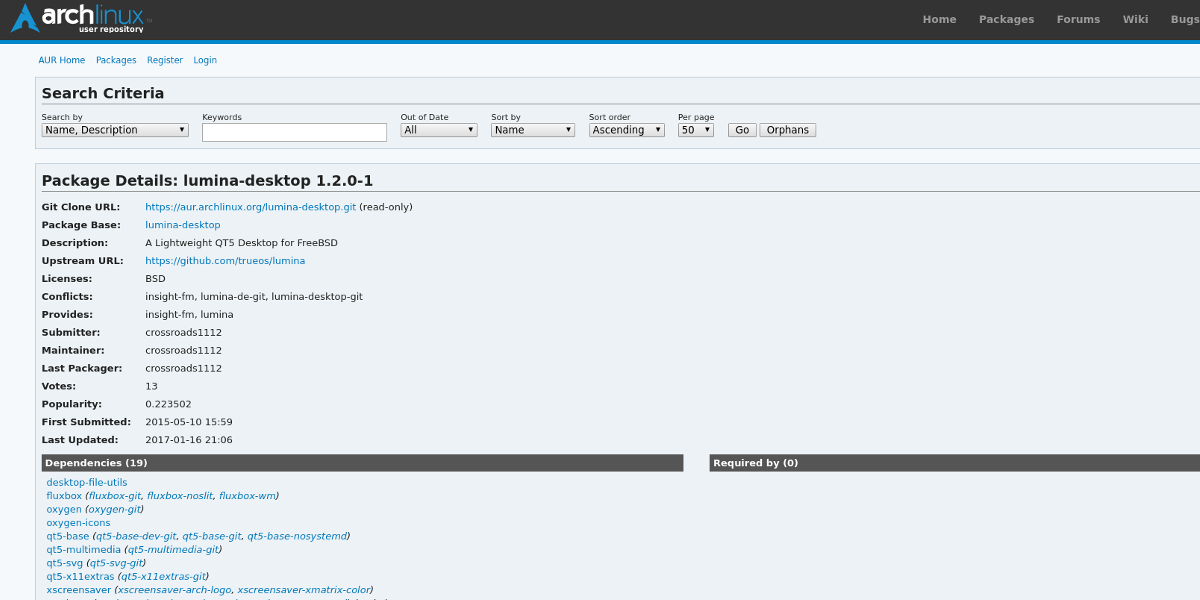Transfer over KDE and Gnome, there’s a brand new desktop atmosphere on the block, and it’s constructed with the BSD platform in thoughts. Lumina is it’s identify, and it has plenty of distinctive options that Linux customers ought to pay attention to. For starters, it’s a Qt5 desktop atmosphere that’s mild in efficiency, that means it could actually run on absolutely anything. Together with that, it has killer ZFS integration which makes restoring file system snapshots a breeze, and extra. There’s loads to like about Lumina, and that’s why it’s been getting plenty of consideration. When you’re questioning precisely what it’s that makes the Lumina desktop so nice, there’s excellent news; you may set up BSD’s Lumina on Linux, with a little bit work. It’s a tedious course of for some variations of Linux, however in the end value it, particularly if you happen to’re eager for one thing completely different.
On this tutorial, we’ll go over precisely the right way to get TrueOS’s Lumina desktop atmosphere compiled, and working on all the main Linux distributions available on the market (and even among the lesser identified ones too).
Set up
Getting the Lumina on Linux is completely different relying on the working system. It is because it was by no means made with Linux in thoughts. Lumina is for the BSD platform. In consequence, getting it working often requires compiling, in a method or one other.
Fedora
Fedora Linux is without doubt one of the solely mainstream Linux distributions proper now that packages and distributes the Lumina desktop atmosphere. Install it to your system with:
sudo dnf-install lumina-desktop
Open SUSE
Getting Lumina on Linux is simple due to the OpenSUSE construct service. Go here, choose your model of SUSE and click on on the “install” button.
Be aware: you’ll want to click on “show unstable packages”.
Arch Linux

Like most software program, the Lumina codebase is freely obtainable on Arch Linux. Arch customers can simply set up this desktop atmosphere, however to take action, they’ll must obtain it’s AUR package construct it, compile it, and use it that approach. As of now, there aren’t any plans so as to add Lumina to any of the principle repositories.
Obtain the newest snapshot and compile it to run in your Arch system. Alternatively, use your favourite AUR helper.
Constructing For Ubuntu and Debian
Earlier than Lumina can compile, some issues must be put in. These are libraries, instruments and packages wanted to construct the supply code. Install them to your system by opening the terminal in your Linux PC, and getting into:
sudo apt set up git
sudo apt-get set up build-essential git qt5-default qttools5-dev-tools libqt5gui5 qtmultimedia5-dev libqt5multimediawidgets5 libqt5network5 libqt5svg5-dev libqt5x11extras5-dev libxcb-icccm4-dev libxcb-ewmh-dev libxcb-composite0-dev libxcb-damage0-dev libxcb-util0-dev libphonon-dev libxcomposite-dev libxdamage-dev libxrender-dev libxcb-image0-dev libxcb-screensaver0-dev qtdeclarative5-dev fluxbox kde-style-oxygen xscreensaver xbacklight alsa-utils acpi numlockx pavucontrol xterm sysstat
With the prolonged quantity of required packages put in, seize the supply code from github, and enter the folder.
git clone lumina
Subsequent, we’ll lay out the best way to compile the supply code on each Debian and Ubuntu. Have in mind, this compilation will take a while. Be affected person.
Debian Directions
Compiling on Debian requires a particular flag in qmake. Begin the qmake compiler device with:
qmake LINUX_DISTRO=Debian
Then, set up the Lumina desktop atmosphere in your Debian PC with make.
make
sudo make set up
Ubuntu Directions
To compile the Lumina desktop on Ubuntu, run the qmake command:
qmake
When the compiler finishes, use make to put in it to the system.
make
sudo make set up
Constructing for Different Linuxes
Customers can compile Lumina on nearly any working system that’s working Linux if the instructions are adopted appropriately. Sadly, each Linux-based working system may be very completely different (completely different package deal names, and methods of putting in issues) so it’s greatest to not define the instructions right here. As an alternative, if you happen to’d wish to get the Lumina desktop atmosphere working, you need to head over to the developer’s Github web page.
The event web page for Lumina reveals the generic directions for the right way to construct the supply code from scratch, and every part in between. Find it here.
Logging Into Lumina
The supply code is constructed and put in on Linux. It’s time to log in. How do you do it? To log into the Lumina desktop, log off of your present desktop atmosphere. Then, look by your DM (desktop supervisor).
Be aware: there are a lot of completely different DM’s on Linux, they usually all look a bit completely different, so the directions on the right way to log in will must be imprecise, to cowl all of them. When on the login display, search for “session”. When you can’t discover “session”, the easiest way to seek out it’s to search for one thing displaying your present desktop atmosphere.
For instance, if you happen to use the Mate desktop, it make say “Mate”. When you use KDE Plasma, the session dropdown menu will say “Plasma”, and so forth.
Click on on the session menu, search for “Lumina”, and click on on it. Then, merely click on in your person and log in!
Conclusion
Although there are limitless quantities of desktop environments to select from on Linux, Lumina is a welcome addition to the membership. It’s deal with tech savvy laptop customers in addition to efficiency is a welcome change, as not many desktop environments are taking this path.
Lumina is likely to be tedious to put in for some, however ultimately if it means getting a desktop atmosphere on Linux that offers customers instruments not discovered on different desktop environments, it’ll be value it.
